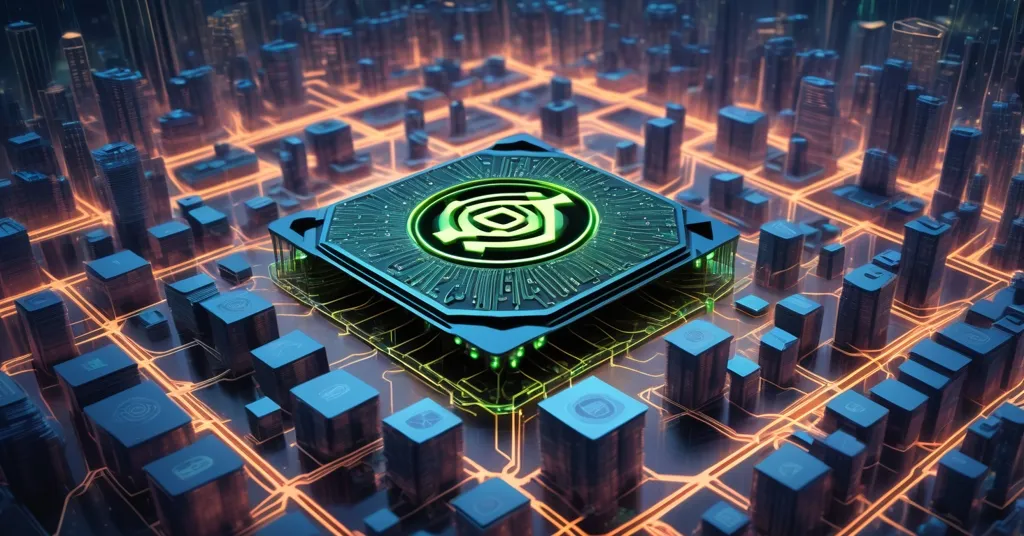Goldman Sachs Raises Nvidia Target to $240: AI Surge and Crypto Mining Ties Explored

Goldman Sachs Ups Nvidia Stock Target to $240: AI Boom Meets Crypto Mining Relevance
Goldman Sachs has turned heads on Wall Street by raising its 12-month price target for Nvidia from $210 to $240, slapping a “buy” rating on the chip titan just before its November 19 earnings report. This bold move screams confidence in Nvidia’s stranglehold on AI infrastructure and data centers, but it’s not all sunshine and rainbows—there’s turbulence in tech land, and for us in the crypto sphere, Nvidia’s story hits closer to home than you might think with its deep ties to mining hardware and potential decentralized tech futures.
- Target Boost: Goldman Sachs hikes Nvidia’s price target to $240, projecting an 18% upside.
- Earnings Watch: Nvidia’s Q3 results drop November 19, with a “beat-and-raise” quarter expected.
- Crypto Connection: Nvidia’s chips power Bitcoin mining and could fuel decentralized AI on blockchain.
Goldman Sachs’ Bullish Bet: Unpacking the Numbers
Nvidia’s stock is already up a jaw-dropping 51% year-to-date, cementing its status as a tech powerhouse. Goldman Sachs analyst James Schneider is doubling down, citing a perfect storm of AI infrastructure announcements and the hype from Nvidia’s recent GTC conference—a major event where the company showcases its latest innovations. He’s not just throwing darts at a board; the numbers back up the optimism. Goldman forecasts Nvidia’s Q3 earnings per share (EPS)—a measure of profitability per stock share—at $1.28, and Q4 EPS at $1.49, beating Wall Street’s consensus by 3% and 5%, respectively. Schneider put it plainly:
“We believe investor expectations have increased heading into the quarter, given multiple AI infrastructure announcements and following the company’s recent GTC event.”
Even more striking is Goldman’s revised datacenter revenue forecast, bumped up by 13%. This surge is fueled by an unstoppable hunger for AI computing power from hyperscalers—think massive cloud service providers like Amazon and Google running huge data centers—and enterprises scrambling for cutting-edge tech. Schneider expects Nvidia to crush it, stating:
“We expect Nvidia to deliver a beat-and-raise quarter, with the stock reaction likely hinging on the level of upside to guidance.”
But what will really sway investors post-earnings? Goldman pinpoints four big drivers: a staggering $500 billion long-term revenue projection, updates on deployments with AI giants like OpenAI (whose models often run on Nvidia hardware), progress on the Rubin chip—a next-gen semiconductor expected in 2025—and the geopolitical mess of export restrictions potentially reopening Nvidia’s business in China. Schneider also noted:
“We expect the debate around: (1) the magnitude of upside to hyperscaler CapEx; (2) contribution from non-traditional customers in CY26 to dictate stock price action into year end.”
AI Hype Lifts Markets, But Volatility Looms Large
Zooming out, AI excitement is setting markets ablaze. The Nasdaq Composite climbed 0.4% recently, powered by Amazon’s AWS cloud unit posting a blistering 20% revenue growth in Q3, which sent its stock rocketing 10%. Amazon CEO Andy Jassy couldn’t help but brag:
“AWS is growing at a pace we haven’t seen since 2022… demand for both AI and infrastructure services remains strong.”
This AI fever lifted other tech stocks like Palantir and Oracle, while October market stats show resilience with the S&P 500 up 2%, Nasdaq over 4%, and the Dow gaining 2% for its sixth straight positive month. But hold the applause—tech isn’t a safe bet. Meta just took a brutal hit, suffering its largest one-day stock drop in three years after burning cash on AI with no quick payoff. It’s a glaring warning: AI might be the golden goose, but you can still lay a rotten egg with billion-dollar gambles. Could Nvidia face a similar stumble, or are they too big to falter?
Nvidia and Crypto: From Mining Rigs to Decentralized Dreams
For those of us obsessed with Bitcoin and blockchain, Nvidia isn’t just another tech stock—it’s a linchpin. Back in the early days, Nvidia’s GPUs (graphics processing units) were the go-to for Bitcoin mining, delivering the raw computational muscle needed to solve complex cryptographic puzzles and secure the network. While ASICs (application-specific integrated circuits) largely took over Bitcoin mining due to their efficiency, Nvidia’s chips remain crucial for smaller operations and altcoin mining where flexibility matters. Even post-Ethereum’s merge to proof-of-stake in 2022, which ditched mining entirely, Nvidia’s hardware finds relevance in other proof-of-work coins and experimental setups.
Looking ahead, there’s a bigger picture. As blockchain evolves beyond just cryptocurrencies, decentralized AI—think machine learning models running on distributed ledger tech—could be the next frontier. Projects like Render Token, which decentralizes GPU rendering, or SingularityNET, aiming for AI marketplaces on blockchain, hint at a future where Nvidia’s high-performance chips play a starring role. Imagine AI training data spread across a permissionless network, powered by the same tech driving today’s data centers. It’s a tantalizing vision for those of us championing decentralization and disrupting the status quo.
But let’s pump the brakes. Could Nvidia’s deep ties to Big Tech giants actually undermine the ethos of decentralization? If hyperscalers dominate AI compute, are we just swapping one corporate overlord for another, even if blockchain’s in the mix? It’s a question worth chewing on—we’re all for effective accelerationism and pushing tech forward, but not at the cost of centralized control. Nvidia could be a key enabler of a decentralized future, or it could just reinforce the same old power structures under a shiny new guise.
Risks on the Horizon: Geopolitical Snags and Hype Hazards
Goldman’s $240 target sounds sexy, but let’s not treat Wall Street predictions as gospel—they’ve been wrong before, and Nvidia faces real headwinds. First up, geopolitics: export restrictions to China, a massive market for tech hardware, could choke off a hefty revenue stream. Analysts have pegged China as accounting for up to 20% of Nvidia’s datacenter sales in past years; losing that, even partially, stings. Then there’s the Rubin chip—slated for 2025, it’s a cornerstone of Nvidia’s future dominance, but delays or underwhelming performance could spook investors. And let’s not forget the $500 billion long-term revenue projection. It’s a headline-grabber, but without clear milestones or transparency, it’s more hype than hard fact.
Beyond specifics, there’s a broader risk: overreliance on AI enthusiasm. Meta’s recent crash shows that pouring billions into AI doesn’t guarantee returns, and Nvidia’s sky-high valuation—trading at a price-to-earnings ratio far above industry averages—screams potential overvaluation. If the AI bubble pops, reminiscent of the dot-com bust, even darlings like Nvidia could take a hit. We’re rooting for disruptive tech to shake up finance and power decentralization, but blind faith in any single player is a fool’s errand. Nvidia must navigate these choppy waters with precision, or that $240 target could turn into a pipe dream.
Future Outlook: Powering a Decentralized Revolution?
Nvidia sits at a fascinating crossroads. On one hand, its dominance in AI chips and data centers positions it as a potential catalyst for decentralized technologies—be it through mining hardware for Bitcoin and altcoins or enabling blockchain-based AI innovations. On the other, geopolitical red tape, innovation pressures, and market volatility remind us that no tech giant is invincible. We’re all about accelerating progress and smashing outdated systems, but Nvidia’s journey is a tightrope walk between empowering a decentralized future and entrenching Big Tech’s grip. The November 19 earnings will be a key litmus test, but the bigger story is whether Nvidia can align with the values of freedom and privacy we hold dear in the crypto space.
Key Questions and Takeaways
- What fuels Goldman Sachs’ confidence in Nvidia’s $240 stock target?
Their optimism stems from Nvidia’s leadership in AI infrastructure, recent industry buzz, the GTC conference impact, and earnings per share forecasts beating Wall Street estimates by 3-5% for Q3 and Q4. - How does AI hype impact broader markets?
AI excitement, driven by Amazon’s 20% AWS growth, pushed the Nasdaq up 0.4%, lifting related tech stocks, though volatility persists with setbacks like Meta’s massive drop over unchecked AI spending. - Why is Nvidia relevant to Bitcoin and cryptocurrency enthusiasts?
Nvidia’s GPUs have powered Bitcoin and altcoin mining for years, and their hardware could underpin future decentralized AI applications on blockchain networks, enhancing distributed computing. - What risks could derail Nvidia’s bullish outlook?
Export restrictions in China risking up to 20% of datacenter revenue, delays with the Rubin chip, and potential AI hype overvaluation could all threaten Nvidia’s growth trajectory. - Could Nvidia’s Big Tech ties clash with decentralization goals?
Yes, while their tech could enable blockchain innovation, reliance on hyperscalers risks centralizing power, countering the ethos of a distributed, permissionless future we advocate for. - How might Nvidia influence decentralized AI on blockchain?
Their high-performance chips could support projects like Render Token or SingularityNET, enabling AI model training on decentralized networks, though scalability and adoption remain unproven. - Should crypto fans trust Wall Street’s Nvidia hype?
Take it with a grain of salt—Goldman’s predictions aren’t infallible, and overblown AI enthusiasm could mirror past tech bubbles, impacting even tangential crypto use cases.



